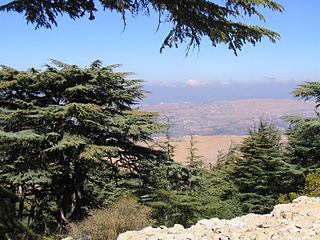
Cedrus, with the common English name cedar, is a genus of coniferous trees in the plant family Pinaceae. They are native to the mountains of the western Himalayas and the Mediterranean region, occurring at altitudes of 1,500–3,200 m in the Himalayas and 1,000–2,200 m in the Mediterranean.

Larches are deciduous conifers in the genus Larix, of the family Pinaceae. Growing from 20 to 45 metres tall, they are native to the cooler regions of the northern hemisphere, where they are found in lowland forests in the high latitudes, and high in mountains further south. Larches are among the dominant plants in the boreal forests of Siberia and Canada. Although they are conifers, larches are deciduous trees that lose their needles in the autumn.

The Pinaceae, or pine family, are conifer trees or shrubs, including many of the well-known conifers of commercial importance such as cedars, firs, hemlocks, piñons, larches, pines and spruces. The family is included in the order Pinales, formerly known as Coniferales. Pinaceae are supported as monophyletic by their protein-type sieve cell plastids, pattern of proembryogeny, and lack of bioflavonoids. They are the largest extant conifer family in species diversity, with between 220 and 250 species in 11 genera, and the second-largest in geographical range, found in most of the Northern Hemisphere, with the majority of the species in temperate climates, but ranging from subarctic to tropical. The family often forms the dominant component of boreal, coastal, and montane forests. One species, Pinus merkusii, grows just south of the equator in Southeast Asia. Major centres of diversity are found in the mountains of southwest China, Mexico, central Japan, and California.
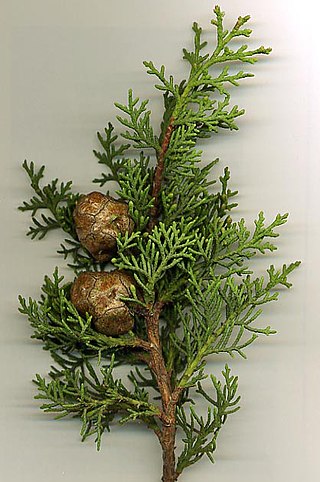
Cupressaceae is a conifer family, the cypress, with worldwide distribution. The family includes 27–30 genera, which include the junipers and redwoods, with about 130–140 species in total. They are monoecious, subdioecious or (rarely) dioecious trees and shrubs up to 116 m (381 ft) tall. The bark of mature trees is commonly orange- to red-brown and of stringy texture, often flaking or peeling in vertical strips, but smooth, scaly or hard and square-cracked in some species.
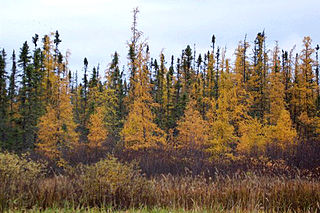
Larix laricina, commonly known as the tamarack, hackmatack, eastern larch, black larch, red larch, or American larch, is a species of larch native to Canada, from eastern Yukon and Inuvik, Northwest Territories east to Newfoundland, and also south into the upper northeastern United States from Minnesota to Cranesville Swamp, West Virginia; there is also an isolated population in central Alaska.

The Bartlett Arboretum and Gardens in Stamford, Connecticut, contains 93 acres of parkland, gardens, landscapes, and hiking trails that focus on the regional plants, ecology and character of Southwestern New England. The Arboretum is open and accessible to the public every day of the year and is located at 151 Brookdale Road.

The Connecticut College Arboretum is a 300 ha arboretum and botanical gardens, founded in 1931, and located on the campus of Connecticut College and in the towns of New London and Waterford, Connecticut, United States.

Boxerwood Nature Center and Woodland Garden is a 15-acre (6.1 ha) arboretum featuring both native and unusual plant specimens, located within a larger preserve at 963 Ross Road near Lexington in Rockbridge County, Virginia, United States in the Shenandoah Valley. Established as a private garden in 1952, it was listed on the National Register of Historic Places in 2015.
The George Landis Arboretum is a public garden comprising hundreds of acres of which 40 are devoted to noteworthy collections and gardens overlooking the Schoharie Valley near Esperance, New York, United States. The physical address is 174 Lape Road. Forty acres of the Arboretum are developed with plantings of trees, shrubs, and herbaceous perennials from around the world, including approximately 2,000 labeled specimens. The remainder of the property consists of natural areas, woodlands, wetlands, more than 8 miles of trails, and open fields. Among the Arboretum's horticultural features are a labeled collection of nearly all the trees, shrubs and vines native to New York State, as well as collections of notable trees, flowering ornamental trees and shrubs, tough trees for tough sites, conifers, and oaks. Two old growth forests and additional natural areas representing various stages of succession await visitors The Van Loveland Perennial Garden at the old farmhouse is a seasonal favorite. Collection signage includes QR codes directed toward audio descriptions.

The University of Delaware Botanic Gardens are botanical gardens and an arboretum located on the campus of the University of Delaware, in Newark, Delaware, United States. The gardens are open to the public without charge.

Taxodium distichum is a deciduous conifer in the family Cupressaceae. It is native to the southeastern United States. Hardy and tough, this tree adapts to a wide range of soil types, whether wet, salty, dry, or swampy. It is noted for the russet-red fall color of its lacy needles.

The Donald E. Davis Arboretum, in Auburn, Alabama, United States, is a public native plants museum, and botanical arboretum with educational facilities, event spaces, and a conservation program. Its grounds, covering 13.5 acres of Auburn University's campus, include cataloged living collections of associated tree and plant communities representative of Alabama's ecosystems, among which is mixed oak forest, carnivorous bog, and longleaf pine savanna. The living collections include more than 1,000 plant types, including 500 different plant species, with over 3,000 cataloged specimens. The Arboretum contains over a mile (2 km) of interwoven walking trails that meander through various southeastern biotopes.

Bickelhaupt Arboretum is a non-profit arboretum located in Clinton, Iowa. It is open dawn to dusk daily without charge.
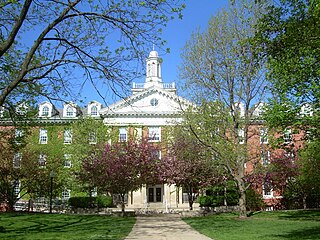
The Fell Arboretum is an arboretum located across the campus of Illinois State University in Normal, Illinois.

Nichols Arboretum, locally known as the Arb, is an arboretum operated by the Matthaei Botanical Gardens and Nichols Arboretum (MBGNA) at the University of Michigan. Located on the eastern edge of its Central Campus at 1610 Washington Heights in Ann Arbor, Michigan, the Arboretum is a mosaic of University and City properties operated as one unit. The arboretum is open daily from sunrise to sunset with no charge for admission. The Huron River separates a northern section of the arboretum's floodplain woods; the railroad marks the northern border.

Peavy Arboretum is an arboretum operated by Oregon State University and located on Arboretum Road, Corvallis, Oregon. It is open to the public daily without charge.

Secrest Arboretum is an arboretum located on the campus of the Ohio Agricultural Research and Development Center (OARDC), at the intersection of Pine Road and Green Drive, Wooster, Ohio. It is open daily without charge and hosts an estimated 10,000 visitors each year.
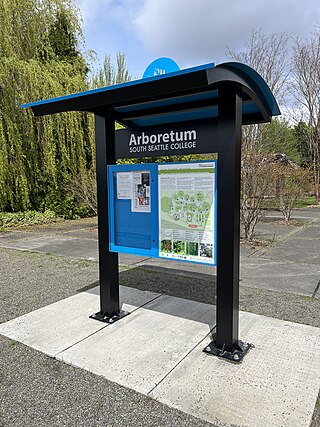
The South Seattle College Arboretum is a 6-acre (24,000 m2) arboretum and botanical garden located at the north end of the South Seattle College campus in Seattle, Washington. It is open daily without charge. The Seattle Chinese Garden is adjacent.

Scott Arboretum is an arboretum coterminous with the campus of and operated by Swarthmore College. It is open to the public daily without charge. The arboretum was established and endowed by the Scott family in 1929 in honor of Arthur Hoyt Scott, "for the purpose of enabling Swarthmore College to acquire, cultivate and propagate the better kinds of living trees, shrubs and herbaceous plants which are hardy in the climate of eastern Pennsylvania and which are suitable for planting by the average gardener."
The Arboretum d'Amance is an arboretum located in Champenoux, Meurthe-et-Moselle, Lorraine, France. It is managed by the Centre INRA de Nancy, a branch of the Institut National de la Recherche Agronomique (INRA), and open on the third Saturday of the warmer months; an admission fee is charged.


















